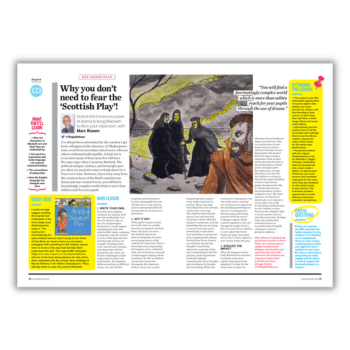Studying Macbeth in KS2 will give pupils access to a fascinatingly complex world which is more than within their reach…
This lesson plan from Marc Bowen shows you how to use the immersive power of drama to bring Macbeth to life in your KS2 classroom.
Macbeth KS2 learning objectives
- Who the characters in Macbeth are and what they are motivated by
- How gesture, expression and body language can express characterisation
- The conventions of playscripts
- How the English language has changed over time
Where to begin
I would strongly suggest avoiding the original text of Macbeth in the early stages of your Shakespearean sojourn. This could prove overwhelming for some children and we aren’t trying to turn them off the Bard; we need to leave our secondary colleagues with something to do!
Instead, expose them to forms of the play that will help them understand the plot. The original BBC Animated Tales is still one of the best interpretations for kids.
Combine this with the cartoon strip retellings of Marcia Williams in Mr William Shakespeare’s Plays to help them to enter the world of Macbeth.
Starter activity
Now that your budding thespians are familiar with the story of Macbeth, it is time for them to take on the role of playwrights themselves.
I would suggest separating the class into mixed-ability teams, assigning each group a specific section or scene of the play; the first meeting with witches, for example.
Working from a scene-specific plot synopsis and using some selected quotations, the teams can then be challenged to draft a playscript for their own performance.
By assigning different portions to different teams, not only will the scripting and performance be more manageable but you will also have a rich starting point to discuss the different interpretations of Shakespearean characters and events.
Marc Bowen is a deputy head and primary teacher in South Wales.

Similar resources
- No Refuge – Graphic novel activities about refugees for UKS2
- Short story writing – Author-led resources for KS1 and KS2
- Christmas activity sheets – KS1 / KS2 fun & educational printables
- Learning gaps – How to ensure no pupil drifts too far
- Writing horror – Write a scary scene with Fear Files: Hide & Seek










